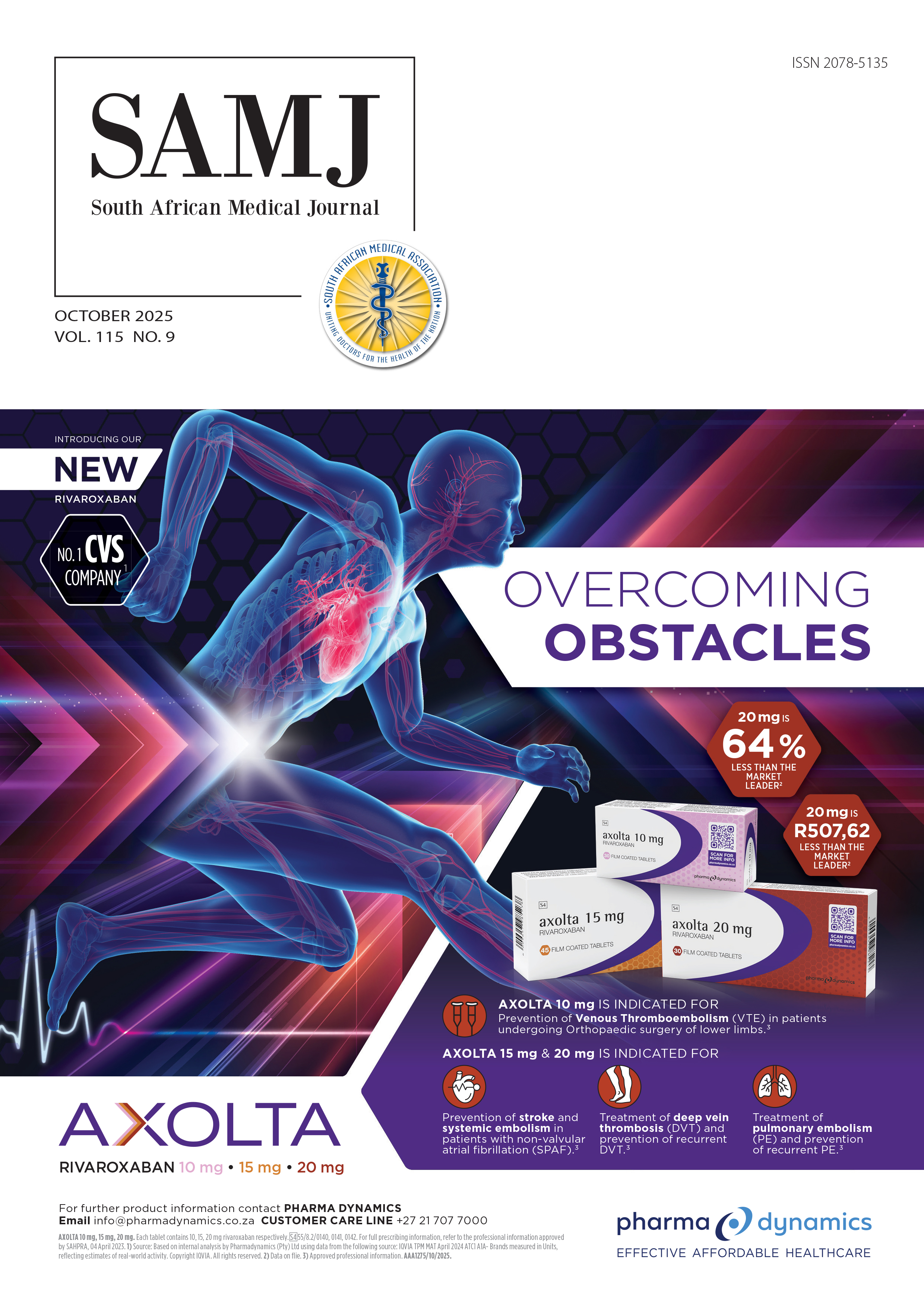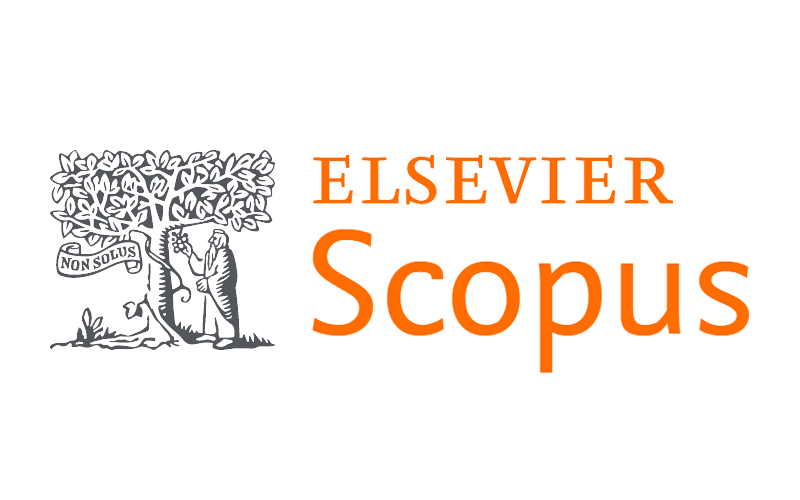A roadmap for kidney health for South Africa in the context of universal health coverage
DOI:
https://doi.org/10.7196/SAMJ.2025.v115i9.4086Keywords:
Chronic kidney disease and transplantationAbstract
Chronic kidney disease (CKD) in South Africa (SA) is a growing public health crisis, driven by the intersecting burdens of HIV, tuberculosis, hypertension, diabetes and obesity. In Black African populations, high-risk apolipoprotein L1 (APOL1) variants add a genetic predisposition to non-diabetic kidney diseases, compounding risk. Global recognition of CKD has recently advanced, marked by the 2025 World Health Organization (WHO) non-communicable disease resolution, which urges the integration of kidney care into national health strategies. This resolution emphasises prevention, early detection and treatment, while strengthening primary healthcare and addressing social determinants of health, particularly in low-income countries. However, in SA, domestic capacity has not kept pace. Public-sector dialysis slots have remained static since 1994, while the private sector has expanded rapidly, deepening inequities by province and income. In the public sector, dialysis is rationed to patients eligible for transplantation, yet transplant access is limited by organ shortages, logistical barriers and variable provincial resources. Expanding deceased donation and implementing kidney paired donation (KPD) programmes are essential to increase transplant opportunities, particularly for incompatible donor- recipient pairs, and to improve equity in access. Children and adolescents face additional barriers, including limited age-specific pathways and the absence of structured transition to adult care. Workforce shortages, inadequate regulatory oversight, inconsistent procurement processes and incomplete registry reporting undermine service quality, limit expansion and perpetuate inequities in access. Without urgent reform, CKD will continue to drive preventable morbidity, premature mortality and escalating costs. Scaling equitable dialysis and transplantation services, integrating KPD and investing in prevention, workforce and infrastructure are critical to reversing current trends and fulfilling the WHO’s call for action.
References
1. Matsha TE, Erasmus RT. Chronic kidney disease in sub-Saharan Africa. Lancet Glob Health 2019;7(12):e1587-e1588. https://doi.org/10.1016/s2214-109x(19)30467-x
2. FabianJ,GondweM,MayindiN,etal.Chronickidneydisease(CKD)andassociatedriskinruralSouth Africa: A population-based cohort study. Wellcome Open Res 2022;7(236):236. https://doi.org/10.12688/ wellcomeopenres.18016.2
3. Allison SJ. Strong association of APOL1 risk variants with HIV-associated nephropathy in black South Africans. Nat Rev Nephrol 2015;11(6):318. https://doi.org/10.1038/nrneph.2015.51.
4. Kasembeli AN, Duarte R, Ramsay M, et al. APOL1 risk variants are strongly associated with HIV- associated nephropathy in black South Africans. J Am Soc Nephrol 2015;26(11):2882-2890. https://doi. org/10.1681/ASN.2014050469
5. Hung RK, Binns-Roemer E, Booth JW, et al. Genetic variants of APOL1 are major determinants of kidney failure in people of African ancestry with HIV. Kidney Int Reports 2022;7(4):786-796. https://doi. org/10.1016/j.ekir.2022.01.1054
6. Gbadegesin RA, Ulasi I, Ajayi S, et al. APOL1 bi- and monoallelic variants and chronic kidney disease in West Africans. N Engl J Med 2025;392(3):228-238. https://doi.org/10.1056/NEJMoa2404211
7. Kovesdy CP. Epidemiology of chronic kidney disease: An update 2022. Kidney Int Suppl 2022;12(1):7-11.
https://doi.org/10.1016/j.kisu.2021.11.003
8. Foreman KJ, Marquez N, Dolgert A, et al. Forecasting life expectancy, years of life lost, and all-cause and cause-specific mortality for 250 causes of death: Reference and alternative scenarios for 2016-40 for 195 countries and territories. Lancet 2018;392(10159):2052-2090.
9. World Health Organization. Reducing the burden of noncommunicable diseases through promotion of kidney health and strengthening prevention and control of kidney disease: Draft decision proposed by Armenia, Belarus, Brazil, Eswatini, European Union and its Member States, Kenya, Malaysia, Namibia, Russian Federation, South Africa, Sri Lanka, Togo, Türkiye, United States of America, and Vanuatu. Report: Executive Board, 156th session. Agenda item 7. Geneva: WHO, 2025. https://apps.who.int/gb/ ebwha/pdf_files/EB156/B156_CONF6-en.pdf (accessed 15 July 2025).
10. EtheredgeH,FabianJ.ChallengesinexpandingaccesstodialysisinSouthAfrica–expensivemodalities, cost constraints and human rights. Healthcare 2017;5(3):38. https://doi.org/10.3390/healthcare5030038
11. Mtingi-NkonzombiL,ManningK,duToitT,MullerE,ReddA,FreercksR.Thestateofkidneyreplacement therapy in Eastern Cape Province, South Africa: A call to action. S Afr Med J 2023;113(4):1143-1149. https://doi.org/10.7196/SAMJ.2023.v113i4.313
12. Wearne N, Okpechi IG, Swanepoel CR. Nephrology in South Africa: Not yet ubuntu. Kidney Dis 2019;5(3):189-196. https://doi.org/10.1159/000497324
13. Davids MR, Marais N, Sebastian S, Jardine T, Chothia M-Y, Jacobs JC. South African Renal Registry Annual Report 2022. Afr J Nephrol 2024;27(1):58-69. https://doi.org/10.21804/27-1-6749
14. ThsehlaE,BoachieMK,GoldsteinS.Cost-effectivenessandbudgetimpactanalysisofperitonealdialysis and haemodialysis in South Africa. BMC Health Serv Res 2025;25(1):100. https://doi.org/10.1186/ s12913-025-12227-5
15. Jardine T, Wong E, Steenkamp R, Caskey FJ, Davids MR. Survival of South African patients on renal replacement therapy. Clin Kidney J 2020;13(5):782-790. https://doi.org/10.1093/ckj/sfaa012
16. Kumashie DD, Tiwari R, Hassen M, Chikte UM, Davids MR. Trends in the nephrologist workforce in South Africa (2002 - 2017) and forecasting for 2030. PLoS ONE 2021;16(8):e0255903. https://doi. org/10.1371/journal.pone.0255903
17. Esezobor CI, Alakaloko AE, Admani B, Ellidir R, Nourse P, McCulloch MI. Paediatric nephrology in Africa. Curr Pediatr Rep 2021;9(4):134-141. https://doi.org/10.1007/s40124-021-00256-7
18. McCulloch MI, Argent AC, Morrow B, et al. Lessons learned from regional training of paediatric nephrology fellows in Africa. Pediatr Nephrol 2023;38(11):3757-3768. https://doi.org/10.1007/s00467- 023-06022-9
19. McCulloch MI, Luyckx VA, Morrow B, et al. Dialysis for paediatric acute kidney injury in Cape Town, South Africa. Pediatr Nephrol 2024;39(9):2807-2818. https://doi.org/10.1007/s00467-024-06399-1
20. Luyckx VA, Moosa MR. Priority setting as an ethical imperative in managing global dialysis access and improving kidney care. Semin Nephrol 2021;41(3):230-241. https://doi.org/10.1016/j. semnephrol.2021.05.004
21. McCullochMI,LuyckxVA,CullisB,etal.Challengesofaccesstokidneycareforchildreninlow-resource settings. Nat Rev Nephrol 2021;17(1):33-45. https://doi.org/10.1038/s41581-020-00338-7
22. Wearne N, Davidson B, Motsohi T, McCulloch M, Krause R. Radically rethinking renal supportive and palliative care in South Africa. Kidney Int Rep 2021;6(3):568-573. https://doi.org/10.1016/j. ekir.2020.11.024
23. Ashuntantang G, Miljeteig I, Luyckx VA. Bedside rationing and moral distress in nephrologists in sub- Saharan Africa. BMC Nephrol 2022;23(1):196. https://doi.org/10.1186/s12882-022-02827-2.
24. Moosa MR, Wearne N. Should we be rationing dialysis in South Africa in the 21st century? Peritoneal Dialysis Int 2018;38(2):84-88. https://doi.org/10.3747/pdi.2017.00179
25. Yang F, Liao M, Wang P, Yang Z, Liu Y. The cost-effectiveness of kidney replacement therapy modalities: A systematic review of full economic evaluations. Appl Health Econ Health Pol 2021;19(2):163-180. https://doi.org/10.1007/s40258-020-00614-4
26. Wolfe RA, Ashby VB, Milford EL, et al. Comparison of mortality in all patients on dialysis, patients on dialysis awaiting transplantation, and recipients of a first cadaveric transplant. N Engl J Med 1999;341(23):1725-1730. https://doi.org/10.1056/NEJM199912023412303
27. Bookholane H, Michaelides A, Prins L, et al. Factors influencing consent rates of deceased organ donation in Western Cape Province, South Africa. S Afr Med J 2020;110(3):204-209. https://doi.org/10.7196/ SAMJ.2020.v110i3.14227.
28. Southern African Transplantation Society, South African Transplant Coordinators Society, Meyer AS, Vuyiseka. 5-Year National Organ Transplant Activity, South Africa, 2017 - 2021. SATS, 2024. https:// sats.org.za/wp-content/uploads/2024/09/5-Year-National-Organ-Transplant-Activity-3.pdf (accessed 25 July 2025).
29. BoosiR,DayalC,ChibaS,KhanF,DaviesM.Effectofdialysismodalityonkidneytransplantoutcomes in South Africa: A single-centre experience. Afr J Nephrol 2025;28(1):59-65. https://doi.org/10.21804/28- 1-6233
30. Barday ZA. ABO-incompatible kidney transplantation using immunoadsorption columns: First experiences in South Africa. S Afr Med J 2024;114(3b):e1326. https://doi.org/10.7196/SAMJ.2024. v114i3b.1326
31. DavidsonB,RaynerB,WearneN,BardayZ,JonesES.Long-termcardio-renal-metaboliccomplications following pre-eclampsia. Cardiology Clinics 2025;43(3):457-467. https://doi.org/10.1016/j. ccl.2024.12.005
32. Chevalier RL. CAKUT: A pediatric and evolutionary perspective on the leading cause of CKD in childhood. Pediatr Rep 2023;15(1):143-153. https://doi.org/10.3390/pediatric15010012
33. Davids MR, Caskey FJ, Eastwood JB. The role of renal registries. In: Banerjee D, Jha V, Annear N, eds. Management of Kidney Diseases. Cham: Springer, 2023:563-573. https://doi.org/10.1007/978-3-031- 09131-5_28
34. VanholderR,AnnemansL,BrownE,etal.Reducingthecostsofchronickidneydiseasewhiledelivering quality health care: A call to action. Nat Rev Nephrol 2017;13(7):393-409. https://doi.org/10.1038/ nrneph.2017.63
35. Duffy M, Ojikutu B, Andrian S, Sohng E, Minior T, Hirschhorn LR. Non-communicable diseases and HIV care and treatment: Models of integrated service delivery. Trop Med Int Health 2017;22(8):926-937. https://doi.org/10.1111/tmi.12901
36. Gorham G, Howard K, Cunningham J, et al. Dialysis attendance patterns and health care utilisation of Aboriginal patients attending dialysis services in urban, rural and remote locations. BMC Health Serv Res 2022;22(1):251. https://doi.org/10.1186/s12913-022-07628-9
37. ThomsonD,MurandaAZ.RevivinganationalstrategyroadmapfororganandtissuedonationinSouth Africa. Afr J Nephrol 2023;26(1):76-77. https://doi.org/10.21804/26-1-5811
Downloads
Published
License
Copyright (c) 2025 N Wearne, Y Chothia, F Bisiwe, B Cullis, R Freercks, V Rekhviashvili , S Wadee, M Davies, N Diana, M McCulloch, G Paget, W van Hougenhouck-Tulleken , Z Barday, L Jacobs, D Thomson, A Muranda

This work is licensed under a Creative Commons Attribution-NonCommercial 4.0 International License.
Licensing Information
The SAMJ is published under an Attribution-Non Commercial International Creative Commons Attribution (CC-BY-NC 4.0) License. Under this license, authors agree to make articles available to users, without permission or fees, for any lawful, non-commercial purpose. Users may read, copy, or re-use published content as long as the author and original place of publication are properly cited.
Exceptions to this license model is allowed for UKRI and research funded by organisations requiring that research be published open-access without embargo, under a CC-BY licence. As per the journals archiving policy, authors are permitted to self-archive the author-accepted manuscript (AAM) in a repository.
Publishing Rights
Authors grant the Publisher the exclusive right to publish, display, reproduce and/or distribute the Work in print and electronic format and in any medium known or hereafter developed, including for commercial use. The Author also agrees that the Publisher may retain in print or electronic format more than one copy of the Work for the purpose of preservation, security and back-up.





